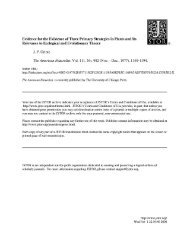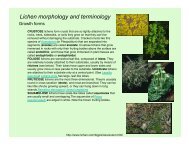Arctic Ecosystems in Russia - Alaska Geobotany Center
Arctic Ecosystems in Russia - Alaska Geobotany Center
Arctic Ecosystems in Russia - Alaska Geobotany Center
You also want an ePaper? Increase the reach of your titles
YUMPU automatically turns print PDFs into web optimized ePapers that Google loves.
364 Yu.I. CHERNOV AND N.V. MATVEYEVA<br />
devoted to them. Nevertheless, the parasites will<br />
not be covered here as they are normally treated as<br />
a special field which is somewhat apart from the<br />
general ecology of terrestrial communities. We<br />
shall only mention a recent review of data on the<br />
disease agents for various mammals <strong>in</strong> the Far<br />
North by Dunaeva (1985), and a series of papers<br />
on the helm<strong>in</strong>ths of northeastern Asia (the symposium<br />
volume Paraziticheskie organizmy Severo-<br />
Vostoka Azii) edited by Kontrimavichus (1975).<br />
Synecological <strong>in</strong>vestigations of Eurasian tundras<br />
started essentially <strong>in</strong> the 1930s, particularly by<br />
analyses of the structure of vegetation cover. These<br />
works were regarded as the scientific basis of<br />
northern re<strong>in</strong>deer breed<strong>in</strong>g. Besides that, maps of<br />
vegetation and geobotanical subdivisions were<br />
used <strong>in</strong> the general plann<strong>in</strong>g of land exploitation<br />
and use of natural resources. In the 1930s, geobotanical<br />
exploration was widely carried out <strong>in</strong> various<br />
tundra regions of the Soviet Union: on the<br />
Yugorskiy pen<strong>in</strong>sula (V.N. Andreyev, 1932, 1935),<br />
on the Yamal (Avramchik, 1937; Nikolaeva,<br />
1941), on Taymyr (V<strong>in</strong>ogradova, 1937; Sambuk,<br />
1937), on Novaya Zemlya (Zubkov, 1934, 1935),<br />
and <strong>in</strong> river bas<strong>in</strong>s, such as the Anabar (Sochava,<br />
1934). Analyses were also made on the abiotic<br />
environment - the climate <strong>in</strong>clud<strong>in</strong>g cryogenic<br />
processes and their <strong>in</strong>fluence on soil and vegetation,<br />
as well as <strong>in</strong>terrelations of processes of soil<br />
genesis and the structure of vegetation (Gorodkov,<br />
1932; Liverovsky, 1934). These works formed the<br />
basis for newer scientific ecological studies of the<br />
tundra and gave impetus to the development of<br />
subsequent, more profound and complex, <strong>in</strong>vestigations<br />
of arctic communities and ecosystems. In<br />
the 1930s, the ma<strong>in</strong> features of structure, zonal<br />
distribution, and regional peculiarities of the vegetation<br />
cover of Eurasian tundras were elucidated,<br />
attempts were made to give a classification of<br />
communities (Sambuk, 1937), and general geobotanical<br />
outl<strong>in</strong>es of the tundra zone were published<br />
(Gorodkov, 1935, 1938).<br />
Before 1940, studies of regional faunas and<br />
autecology dom<strong>in</strong>ated <strong>in</strong> zoological research on<br />
the <strong>Russia</strong>n tundra. Some species - for example,<br />
the polar fox (Alopex lagopus) and the willow<br />
ptarmigan (Lagopus lagopus) - were studied <strong>in</strong><br />
connection with their economic use. A number of<br />
papers presented important data on the numbers<br />
of birds and mammals and their distribution<br />
among biotypes as well as their <strong>in</strong>terrelations with<br />
the abiotic and biotic environment (e.g., Naumov,<br />
1931; Sdobnikov, 1937). At the same time, Fridol<strong>in</strong><br />
(1936) studied <strong>in</strong> detail the cenotic relations<br />
of the subarctic, the Khib<strong>in</strong>y mounta<strong>in</strong>s. This<br />
work played an important role <strong>in</strong> the development<br />
of biocenological <strong>in</strong>vestigations <strong>in</strong> the North.<br />
Dur<strong>in</strong>g the Second World War, the exploration<br />
of tundras was slowed down, but a series of<br />
<strong>in</strong>terest<strong>in</strong>g ecological <strong>in</strong>vestigations were still conducted.<br />
Tikhomirov (1946), later a prom<strong>in</strong>ent tundra<br />
specialist, wrote a paper of particular <strong>in</strong>terest<br />
on the meadow plant communities of the tundra<br />
zone dur<strong>in</strong>g the blockade of Len<strong>in</strong>grad. In 1941-<br />
1943, extensive year-round <strong>in</strong>vestigations on the<br />
Yamal led to fundamental papers on the ecology<br />
of birds of prey (Osmolovskaya, 1948) and of<br />
voles (Microt<strong>in</strong>ae) (Dunaeva, 1948). These papers<br />
were of great importance for the development of<br />
tundra biocenology. They showed for the first time<br />
the important dependence of population dynamics<br />
on trophic relations and the state of forage reserves<br />
under tundra conditions. Later on, many of<br />
their hypotheses were confirmed <strong>in</strong> other regions<br />
and on other objects.<br />
A monograph by Grigor'ev (1956) has played a<br />
noteworthy role <strong>in</strong> tundra science. In this book,<br />
Grigor'ev, the head of a prom<strong>in</strong>ent school of<br />
geographers, analyzed the general regularities of<br />
<strong>in</strong>teractions of the vegetation cover and the animal<br />
k<strong>in</strong>gdom of the tundra with the physicogeographical<br />
environment. He outl<strong>in</strong>ed the pr<strong>in</strong>ciples and<br />
criteria of subdivision of the polar territories.<br />
In the 1950s, a still greater <strong>in</strong>terest <strong>in</strong> synecological<br />
problems and <strong>in</strong> complex analyses of the<br />
<strong>in</strong>terrelations of organisms among themselves and<br />
with the abiotic environment arose among the<br />
Soviet explorers of the north. In these years, the<br />
last works of the outstand<strong>in</strong>g tundra specialist<br />
Gorodkov were published. The traditions of tundra<br />
ecology were cont<strong>in</strong>ued by his successors,<br />
Aleksandrova and Tikhomirov. The descriptions<br />
of plant cover <strong>in</strong> the subzone of arctic tundras<br />
(Gorodkov, 1952, 1956, 1958; Aleksandrova,<br />
1956) are fundamental <strong>in</strong>vestigations elucidat<strong>in</strong>g<br />
the problems of phytocenology and the nomenclature<br />
and distribution of plant communities, as<br />
dependent on various biotic and abiotic factors. A<br />
number of <strong>in</strong>terest<strong>in</strong>g biocenological works were<br />
published by Tikhomirov on the structure of plant<br />
communities <strong>in</strong> relation to cryogenesis, on the<br />
cenotic role of mosses, and on the <strong>in</strong>fluence of<br />
animals on plant cover (Tikhomirov, 1952, 1957,<br />
1959).




